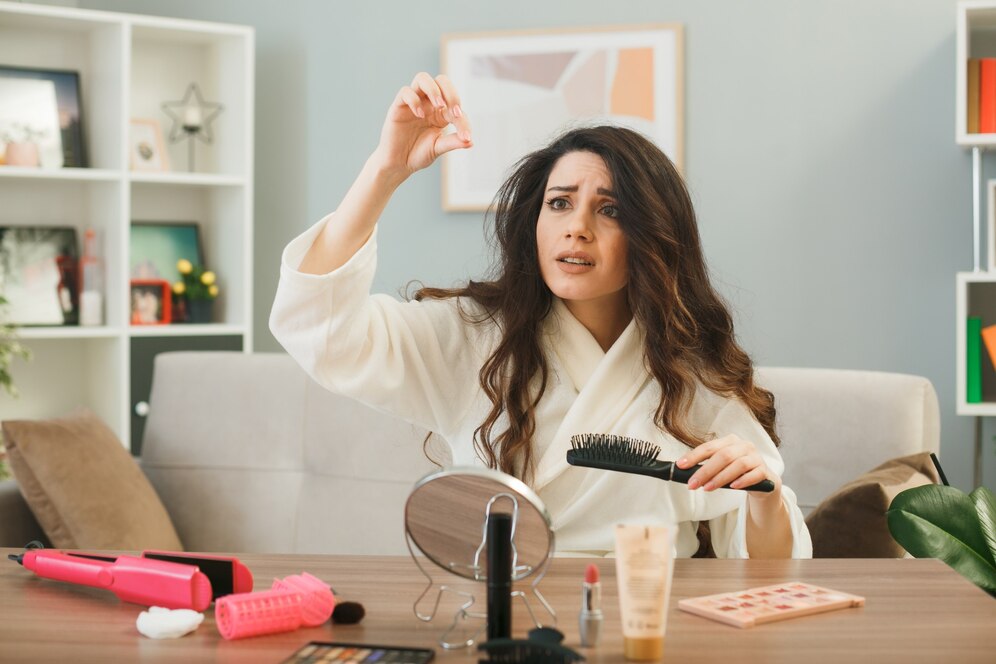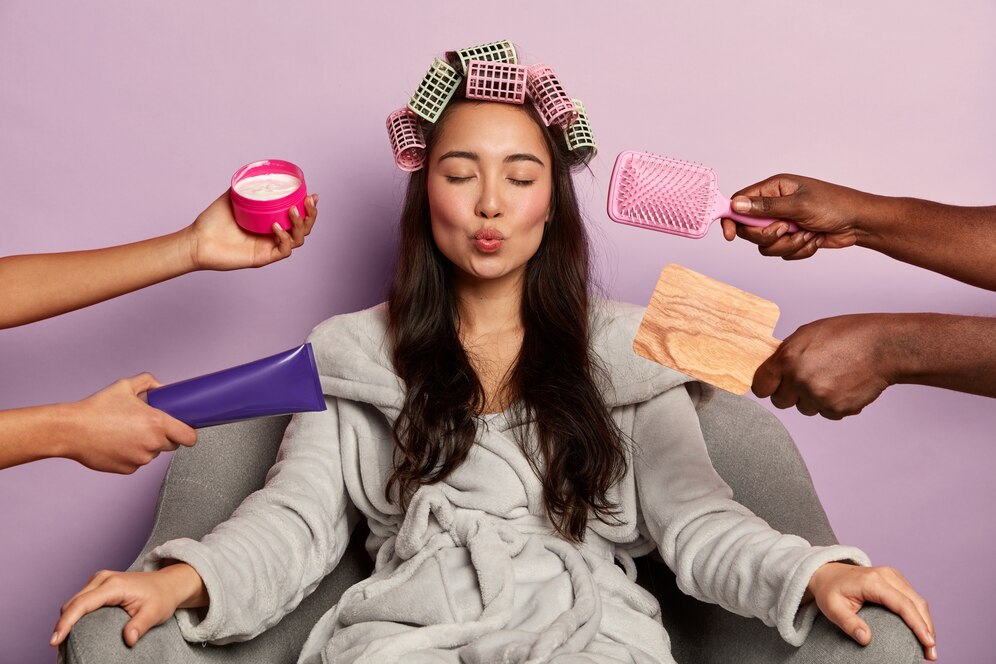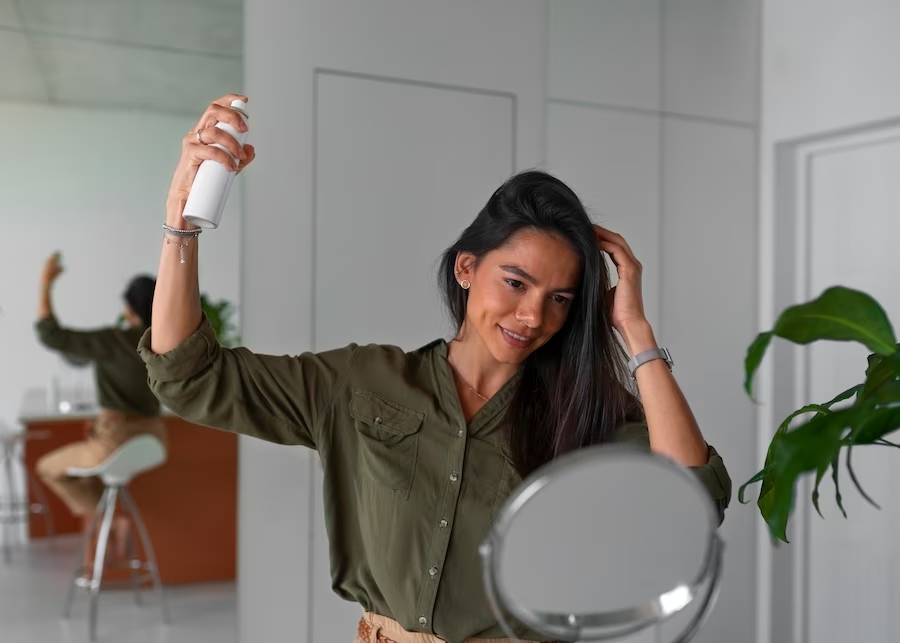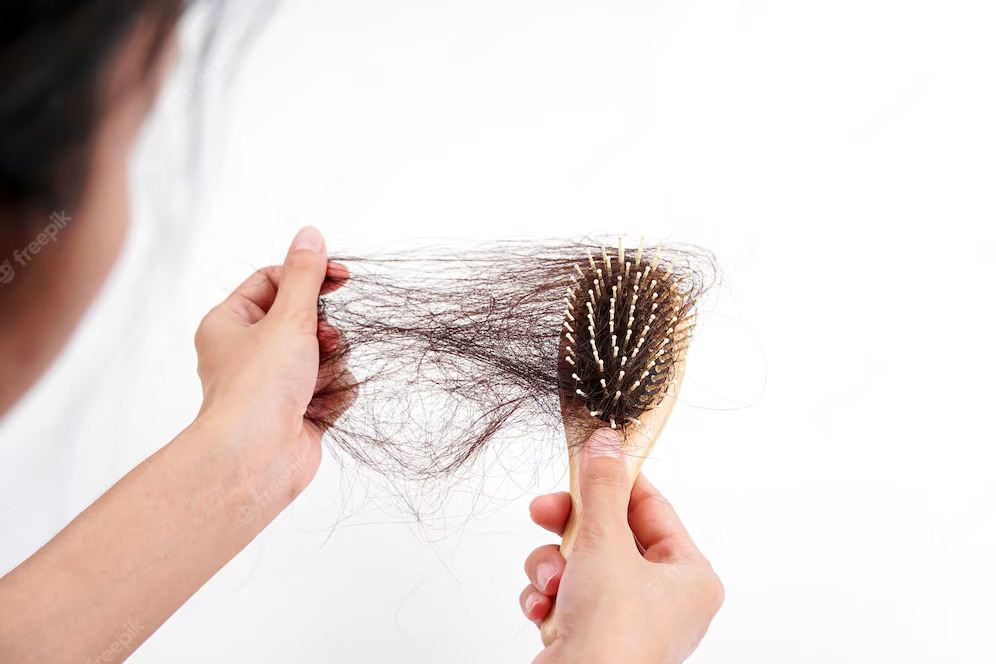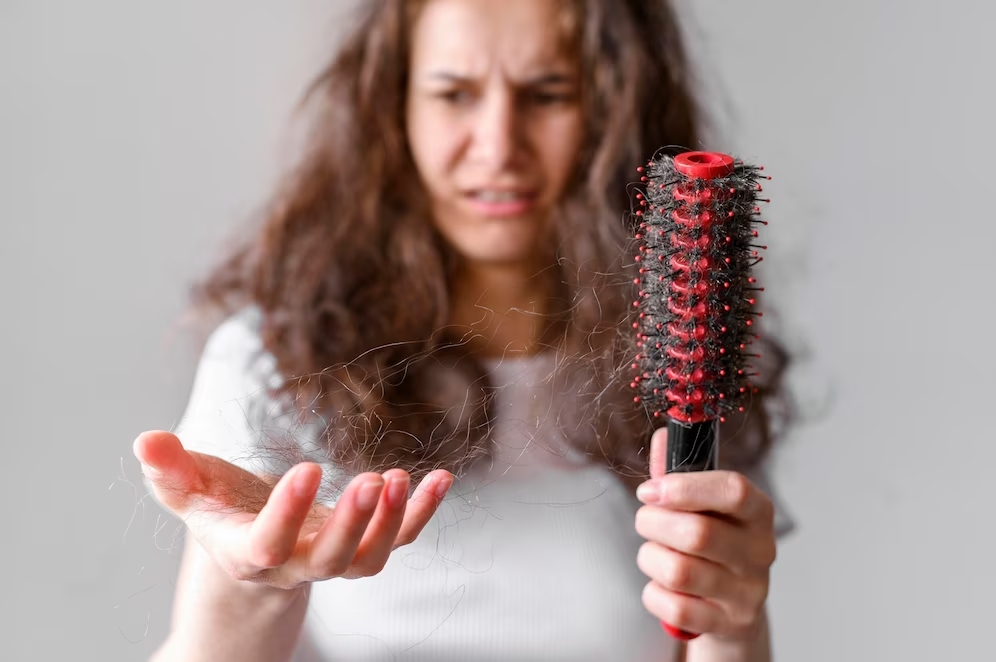In a world brimming with hair products boasting miraculous transformations, the allure of natural hair care routines beckons like an oasis in a desert. Imagine a hair care regimen that not only promises luscious locks but also treads lightly on the environment and your wallet. This comprehensive guide takes you on a journey through the realms of natural hair care, divulging the essential ingredients that can elevate your tresses and imparting the wisdom of DIY recipes for hair that exudes vitality. Bid farewell to your hair woes and greet the age-old wisdom of nature with open arms.
Understanding Your Hair
The Fundamentals of Hair Types
Before you embark on your quest for a natural hair care routine, it’s essential to comprehend the basics—your hair type. Hair comes in a diverse spectrum of types, including straight, wavy, curly, and coily. These classifications are not merely for aesthetic purposes; they dictate how your hair responds to various treatments and products.
Straight hair tends to be naturally oily because the sebum can easily travel down the hair shaft. On the flip side, curly and coily hair often experiences dryness due to the difficulty of sebum to navigate the twists and turns. Wavy hair falls somewhere in between, with its own unique set of characteristics.
Why Knowing Your Hair Type Matters
Understanding your hair type isn’t merely about categorizing your locks; it’s about tailoring your hair care routine to its specific needs. Just as you wouldn’t use the same skincare products for oily and dry skin, your hair deserves specialized attention too.
For instance, if you have curly or coily hair, you’ll want to focus on moisturizing products to combat dryness. On the contrary, those with straight hair may need to pay more attention to oil control. Knowing your hair type will also guide your choice of natural ingredients and DIY recipes, ensuring that they are perfectly suited to nourish and enhance your unique mane.
The Essential Ingredients
Coconut Oil: Nature’s Elixir for Hair
Benefits and Uses
Coconut oil has earned its reputation as a natural hair care elixir. This versatile oil is rich in lauric acid, which can penetrate the hair shaft, reducing protein loss and strengthening your hair from within. It also possesses antibacterial and antifungal properties, making it a potent ally in combating scalp issues.
The benefits of coconut oil extend beyond hair strength. It’s an excellent conditioner, leaving your hair soft and shiny. Whether used as a pre-shampoo treatment, a leave-in conditioner, or even in a hair mask, coconut oil can work wonders for your locks.
How to Choose the Right Coconut Oil
Not all coconut oils are created equal. When selecting coconut oil for your hair care routine, opt for unrefined, virgin, or cold-pressed varieties. These types retain more of the beneficial nutrients and are free from harmful additives.
Keep in mind that a little goes a long way with coconut oil. Start with a small amount and adjust as needed. For a deep conditioning treatment, warm the oil slightly and apply it evenly to your hair, focusing on the ends. Leave it on for at least 30 minutes, or overnight for an intensive treatment, and then wash it out with your regular shampoo.
Aloe Vera: The Miracle Plant for Hair
Aloe Vera Gel vs. Juice: Which is Better?
Aloe vera has long been revered for its soothing and healing properties. When it comes to hair care, both aloe vera gel and aloe vera juice can work wonders, but they have slightly different applications.
Aloe vera gel, obtained from the inner leaf, is a thicker substance and is excellent for moisturizing your hair and scalp. It can be applied directly to the hair as a leave-in conditioner, providing hydration and promoting hair growth. Its cooling properties can also alleviate scalp irritation.
On the other hand, aloe vera juice, often derived from the whole leaf, is lighter in texture and is ideal for use in homemade shampoos and conditioners. It can help cleanse the scalp and balance the pH level, leaving your hair clean and healthy.
DIY Aloe Vera Hair Products
Creating your own aloe vera-based hair products is easier than you might think. For a simple and effective aloe vera conditioner, mix equal parts aloe vera gel and water and apply it to your hair after shampooing. Leave it on for a few minutes before rinsing thoroughly. This DIY conditioner will leave your hair feeling soft and manageable.
For a homemade aloe vera shampoo, combine aloe vera juice with a gentle liquid castile soap and a few drops of your favorite essential oil for fragrance. This concoction cleanses your hair without stripping away its natural oils, making it perfect for regular use.
Honey: The Sweet Solution for Hair Health
Why Honey is Great for Your Hair
Honey, that golden elixir from the bees, isn’t just for sweetening your tea. It’s also a natural humectant, which means it attracts and retains moisture. When applied to your hair, honey helps lock in hydration, leaving your locks soft, shiny, and frizz-free.
Honey is also rich in antioxidants and nutrients, which can promote hair growth and prevent hair loss. Its antibacterial properties can help maintain a healthy scalp, reducing the likelihood of dandruff and other scalp issues.
DIY Honey Hair Masks and Treatments
Incorporating honey into your hair care routine is a cinch with these DIY recipes. For a deep conditioning honey mask, mix two tablespoons of honey with one tablespoon of coconut oil. Apply this mixture to your hair, focusing on the ends, and leave it on for 20-30 minutes before shampooing and rinsing thoroughly. This mask will revive even the driest of hair.
For those with oily hair, a honey and lemon juice mixture can work wonders. Combine two tablespoons of honey with the juice of half a lemon and a cup of water. Use this concoction as a final rinse after shampooing to help control excess oil and add shine to your hair.
DIY Recipes for Gorgeous Hair
Hydrating Coconut Oil Hair Mask
Ingredients and Preparation
For a hydrating coconut oil hair mask that will leave your locks looking and feeling luxurious, you’ll need:
- 2 tablespoons of virgin coconut oil
- 1 tablespoon of honey
- 1 egg (optional, for added protein)
Begin by melting the coconut oil until it’s in a liquid state, but not too hot. Add the honey and egg (if using) to the melted coconut oil and mix thoroughly. Make sure the mixture is well-blended, and there are no lumps.
Application and Results
Apply the mask to your dry or slightly damp hair, starting from the roots and working your way to the ends. Gently massage your scalp to ensure the mixture is evenly distributed. Once your hair is coated, cover it with a shower cap or a warm towel to trap in heat and enhance absorption.
Leave the mask on for at least 30 minutes, or for an even more intensive treatment, leave it on overnight. When it’s time to rinse, use lukewarm water and a mild, sulfate-free shampoo. You may need to shampoo twice to remove all the oil. Finish with a conditioner if desired.
After using this hydrating coconut oil hair mask, you’ll notice a remarkable difference in the texture of your hair. It will be softer, smoother, and deeply nourished. With regular use, you’ll also experience reduced frizz and improved hair elasticity.
Aloe Vera and Honey Shampoo
Creating Your Natural Shampoo
To craft your own aloe vera and honey shampoo, you’ll need:
- 1/2 cup of aloe vera juice
- 1/4 cup of honey
- 1/4 cup of liquid castile soap (unscented or a fragrance of your choice)
- 10-15 drops of essential oil (e.g., lavender, rosemary, or tea tree)
Start by mixing the aloe vera juice and honey in a bowl until they are well-blended. Then, add the liquid castile soap and essential oil, and stir gently. The essential oil not only provides a pleasant fragrance but also offers additional benefits for your hair.
How to Use and What to Expect
Using your homemade aloe vera and honey shampoo is simple. Wet your hair thoroughly, just as you would with a regular shampoo. Pour a small amount of your DIY shampoo into your hands and work it into your hair and scalp, massaging gently. Enjoy the delightful lather that forms as you cleanse your hair.
Rinse your hair thoroughly with lukewarm water until all the shampoo is washed out. You may need to repeat this process if you have a lot of product buildup or oily hair. Follow up with a conditioner if needed.
This DIY shampoo offers a gentle yet effective cleanse. It leaves your hair feeling clean, soft, and manageable without stripping away its natural oils. The combination of aloe vera and honey ensures that your hair is well-hydrated and free from harsh chemicals, making it an excellent choice for those looking to switch to a natural hair care routine.
Honey and Avocado Hair Conditioner
Whipping Up the Perfect Conditioner
Creating a honey and avocado hair conditioner is surprisingly simple, and the results are outstanding. Here’s what you’ll need:
- 1 ripe avocado
- 2 tablespoons of honey
- 1 tablespoon of olive oil
- 1 egg yolk (optional, for added protein)
Start by scooping out the flesh of the ripe avocado and mashing it in a bowl until it’s smooth and free of lumps. Add the honey, olive oil, and egg yolk (if using) to the mashed avocado. Mix all the ingredients together until you have a creamy, well-blended conditioner.
Tips for Maximum Effectiveness
Applying your homemade honey and avocado conditioner is a delightful experience. Begin by shampooing your hair as usual and rinsing it thoroughly. Then, squeeze out any excess water and apply your conditioner generously, focusing on the lengths and ends of your hair. Gently massage the conditioner into your hair, ensuring it’s evenly distributed.
Now, here’s the secret to maximizing its effectiveness—wrap your hair in a warm towel or cover it with a shower cap. The heat helps the conditioner penetrate your hair shaft, allowing the nutrients to work their magic. Leave the conditioner on for at least 30 minutes. For an even more luxurious treatment, leave it on for an hour or longer.
After the designated time, rinse your hair with lukewarm water until the conditioner is completely washed out. You’ll immediately notice the difference. Your hair will be incredibly soft, manageable, and radiantly healthy. With regular use, this honey and avocado conditioner will help repair damage and restore vitality to your locks.
Natural Rinses for Hair Health
Chamomile Rinse for Blonde Brilliance
Brewing the Perfect Chamomile Rinse
For those with blonde or light-colored hair, a chamomile rinse can work wonders to enhance your hair’s natural shine and vibrancy. Here’s how to prepare it:
- 2-3 chamomile tea bags or 2-3 tablespoons of dried chamomile flowers
- 2 cups of hot water
- A squeeze of lemon juice (optional)
Start by steeping the chamomile tea bags or dried flowers in hot water for about 15 minutes. Allow the infusion to cool down to room temperature, and if desired, add a squeeze of lemon juice for an extra brightening effect.
How to Maintain Blonde Hair
Using the chamomile rinse is as simple as pouring it over your clean, wet hair as a final rinse after shampooing. Massage it into your hair and scalp gently, ensuring that it’s evenly distributed. You can let it sit for a minute or two before rinsing it out with cold water.
The chamomile rinse not only imparts a beautiful golden hue to blonde hair but also adds a natural shine. It’s a fantastic alternative to chemical-laden hair treatments. Incorporating this rinse into your hair care routine once or twice a week can help maintain your blonde locks and keep them looking their best.
Rosemary Rinse for Hair Growth
Harnessing Rosemary’s Growth Powers
Rosemary is renowned for its hair-strengthening and growth-promoting properties. It stimulates blood circulation in the scalp, which, in turn, promotes hair growth. To prepare a rosemary rinse, you’ll need:
- 2-3 sprigs of fresh rosemary or 2-3 tablespoons of dried rosemary
- 2 cups of hot water
Begin by steeping the rosemary in hot water for about 15-20 minutes. This allows the rosemary’s essential oils and nutrients to infuse into the water, creating a potent hair-enhancing elixir.
Incorporating Rosemary into Your Routine
Using your rosemary rinse is simple and can be done as a final step after your regular shampoo and conditioning routine. Allow the rinse to cool down to a comfortable temperature, and then pour it over your clean, wet hair. Gently massage your scalp as you pour to ensure the rosemary-infused water is evenly distributed.
There’s no need to rinse it out afterward. Simply let your hair air dry, and you’ll notice a subtle improvement in hair thickness and overall health with regular use. Rosemary is also known to reduce dandruff and scalp irritation, making it a well-rounded choice for holistic hair care.
Apple Cider Vinegar: The Natural Clarifier
Why ACV is a Game-Changer
Apple cider vinegar (ACV) is a versatile kitchen staple that can also transform your hair. It acts as a natural clarifier, helping to remove product buildup, excess oil, and residue from hard water. This, in turn, leaves your hair cleaner, shinier, and more manageable.
The acidity of ACV helps to balance the pH level of your scalp, which is essential for a healthy scalp and hair. It also has mild antibacterial and antifungal properties, making it an excellent choice for those prone to scalp issues like dandruff.
The ACV Rinse Process
Using an ACV rinse is straightforward. Start by mixing one to two tablespoons of raw, unfiltered apple cider vinegar with a cup of water. You can adjust the ratio depending on the sensitivity of your scalp. The more sensitive your scalp is, the more water you should use.
After shampooing and conditioning your hair, tilt your head back and pour the ACV mixture over your hair. Be careful to avoid getting it in your eyes, as the acidity can cause irritation. Gently massage your scalp as you pour to ensure even distribution.
Leave the ACV rinse on your hair for a minute or two before rinsing it out thoroughly with cold water. The cold water helps seal the hair cuticles, leaving your hair smoother and shinier.
Incorporate this natural clarifying rinse into your hair care routine once a week or as needed to keep your locks free from buildup and your scalp in optimal condition.
Tackling Common Hair Issues Naturally
Banishing Dandruff with Tea Tree Oil
How to Use Tea Tree Oil Effectively
Dandruff can be an unwelcome guest on your scalp, but it doesn’t have to overstay its welcome. Tea tree oil, with its potent antifungal and antibacterial properties, can help banish dandruff and provide relief from an itchy scalp.
To use tea tree oil effectively, you’ll need to dilute it to prevent skin irritation. Mix a few drops of tea tree oil with a carrier oil, such as coconut oil or jojoba oil. The exact ratio may vary depending on your scalp’s sensitivity, so start with a small amount and adjust as needed.
Apply the diluted tea tree oil mixture to your scalp, massaging it gently. Leave it on for at least 15-30 minutes, or you can even leave it on overnight for an intensive treatment. Then, shampoo and condition your hair as usual.
With regular use, tea tree oil can help reduce dandruff and soothe scalp irritation. It’s a natural alternative to commercial dandruff shampoos, which often contain harsh chemicals.
Repairing Split Ends with Papaya
The Papaya Hair Mask Recipe
Split ends are the nemesis of healthy, luscious locks. Fortunately, you can rescue your hair from this predicament with a nourishing papaya hair mask. To create this mask, you’ll need:
- 1 ripe papaya
- 1 tablespoon of honey
- 1 tablespoon of yogurt
Start by peeling and deseeding the papaya, then cut it into small pieces. Use a blender to puree the papaya until it’s smooth. Add honey and yogurt to the papaya puree and blend everything together until you have a creamy mixture.
Tips for Preventing Future Split Ends
Applying the papaya hair mask is a rejuvenating experience. Begin by shampooing your hair and rinsing it thoroughly. Squeeze out excess water and apply the mask generously, focusing on the ends of your hair where split ends are most prevalent.
Gently massage the mask into your hair and scalp, ensuring it’s evenly distributed. Cover your hair with a shower cap or a warm towel to lock in heat and enhance absorption. Leave the mask on for at least 30 minutes, allowing the papaya’s natural enzymes to work their magic.
Rinse your hair with lukewarm water until the mask is completely washed out. You’ll immediately notice the difference. Your hair will feel softer, smoother, and more manageable. With regular use, this papaya hair mask will help repair split ends and prevent future damage.
Strengthening Weak Hair with Egg
The Benefits of Eggs for Hair
Eggs are not only a powerhouse of nutrition for your body but also a treasure trove of benefits for your hair. They are packed with protein, vitamins, and minerals that can strengthen weak, brittle hair.
The protein in eggs helps repair damaged hair shafts and promotes hair growth. Eggs are also rich in biotin, a B vitamin known for its role in maintaining healthy hair and nails. Additionally, the vitamins A, D, and E in eggs nourish the scalp and hair follicles, promoting overall hair health.
Egg-Based Hair Treatments
Incorporating eggs into your hair care routine is easy. One popular method is creating an egg mask. To make a basic egg mask, whisk one or two eggs (depending on your hair length) in a bowl until they are well beaten. You can add a tablespoon of honey or olive oil for extra hydration.
Apply the egg mask to clean, damp hair, starting from the roots and working your way to the tips. Massage it into your scalp and hair, ensuring that it’s evenly distributed. Cover your hair with a shower cap or warm towel and leave the mask on for 20-30 minutes.
Rinse your hair with cool or lukewarm water to prevent the egg from cooking on your hair. Shampoo and condition your hair as usual. You’ll be amazed by the immediate difference in hair texture and strength.
Regular egg-based treatments can help repair weak hair, reduce breakage, and promote overall hair health. Incorporate them into your routine to enjoy stronger, more resilient locks.
Sustainable Hair Care
Eco-Friendly Choices for Your Hair
Reducing Environmental Impact
Sustainable hair care isn’t just about making your hair look great; it’s about making choices that minimize your environmental impact. Traditional hair care products often contain harsh chemicals and come in single-use plastic packaging, contributing to pollution and harming ecosystems.
One way to reduce your environmental footprint is by choosing natural and organic hair care products. These products are often biodegradable, which means they break down harmlessly in the environment. Look for brands that use recyclable or compostable packaging to further reduce waste.
Additionally, consider reducing water waste by taking shorter showers and turning off the tap while you lather and condition your hair. Installing a low-flow showerhead can also help conserve water without sacrificing water pressure.
Choosing Sustainable Hair Products
When shopping for hair care products, look for labels and certifications that indicate eco-friendliness and sustainability. Labels like “organic,” “cruelty-free,” and “vegan” are good indicators that a product aligns with ethical and sustainable practices.
Supporting brands that are committed to sustainability not only benefits the environment but also sends a message to the industry that consumers value eco-conscious choices. By making informed choices, you contribute to a cleaner, healthier planet.
Cruelty-Free Hair Care
Understanding Cruelty-Free Labels
Cruelty-free hair care means that no animals were harmed in the testing or production of the products you use. Unfortunately, many conventional hair care brands still engage in animal testing, subjecting animals to unnecessary suffering.
To ensure your hair care routine aligns with ethical values, look for products labeled as “cruelty-free.” These products have not been tested on animals, and they often display logos from organizations like PETA or Leaping Bunny to certify their cruelty-free status.
Choosing cruelty-free products supports the movement to end animal testing in the beauty industry and encourages more brands to adopt ethical testing practices.
Supporting Ethical Brands
When you opt for cruelty-free hair care products, you’re not only making a compassionate choice but also promoting the welfare of animals. Your purchasing power sends a clear message to companies that ethical practices matter.
Research and choose brands that prioritize both the quality of their products and the well-being of animals. Many cruelty-free brands offer a wide range of hair care products, from shampoos and conditioners to styling products, so you can build a cruelty-free hair care routine that suits your needs.
As you venture into the world of natural hair care, you’ll discover the power of nature’s ingredients to transform your hair into a luscious mane that’s not only beautiful but also healthy. Whether it’s the nourishing properties of coconut oil, the soothing effects of aloe vera, or the hydration of honey and avocado, nature provides an abundance of solutions for your hair needs.
By incorporating these natural ingredients into your DIY hair care routine and adopting sustainable and cruelty-free practices, you’re not only enhancing your hair’s vitality but also contributing to a cleaner, more compassionate world. Embrace the wisdom of nature and let your hair radiate with the beauty it deserves.
FAQs
Is it safe to use natural ingredients on color-treated hair?
Yes, many natural ingredients are safe for color-treated hair. However, it’s essential to be cautious and do a patch test before applying any new ingredient. Some natural ingredients, like lemon juice or henna, can interact with hair dye and alter the color. Always consult with a professional hairstylist or colorist if you have concerns.
How often should I use hair masks in my routine?
The frequency of using hair masks depends on your hair type and its condition. In general, once a week is a good starting point. For extremely damaged or dry hair, you may use a hair mask twice a week. If your hair is already healthy, once every two weeks or once a month is sufficient for maintenance.
Are there any potential side effects of natural hair care ingredients?
While natural ingredients are generally safe, some people may be sensitive or allergic to specific substances. Always perform a patch test before using a new ingredient to check for any adverse reactions. Additionally, be cautious with ingredients like lemon juice or baking soda, which can be drying if overused.
Can I mix different natural ingredients together for a super-hair treatment?
Absolutely! Mixing various natural ingredients can create potent hair treatments tailored to your specific needs. However, be mindful of potential interactions between ingredients and ensure that your hair can benefit from the combination you choose. Experimentation is key to finding the perfect blend for your hair.
Is it possible to overdo natural hair care and damage my hair?
Yes, it’s possible to overdo natural hair care, just as it is with commercial products. Overusing certain ingredients, such as lemon juice or baking soda, can lead to dryness or damage over time. It’s essential to strike a balance and listen to your hair’s needs. Pay attention to how your hair responds to different treatments and adjust your routine accordingly.
What’s the best way to transition from commercial to natural hair care products?
Transitioning to natural hair care products is a gradual process. Start by incorporating one natural product at a time, such as a homemade shampoo or conditioner. Allow your hair and scalp to adjust to the new routine before introducing more natural products. Remember that your hair may go through a detox phase as it adapts to the absence of commercial chemicals, so be patient and persistent.

David M is a seasoned author renowned for his expertise in health tips and homemade remedies. With a passion for wellness, he diligently researches and meticulously analyzes a plethora of online resources, ensuring their credibility. David’s dedication shines through as he curates invaluable information, catering to health enthusiasts.


